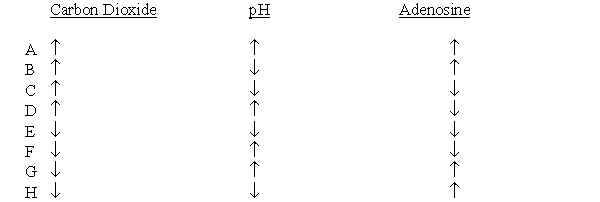Deck 17: Local and Humoral Control of Tissue Blood Flow
Question
Question
Question
Question
Question
Question
Question
Question
Question
Question

Unlock Deck
Sign up to unlock the cards in this deck!
Unlock Deck
Unlock Deck
1/10
Play
Full screen (f)
Deck 17: Local and Humoral Control of Tissue Blood Flow
1
Histamine is injected into the brachial artery of a 25-year-old man. Which set of changes would be expected to occur in response to histamine? 

D
2
Reducing arterial pressure in a muscle artery from 100 to 80 mm Hg would result in which of the following?
A)Long-term reduction in blood flow
B)Reduction in arteriole diameter and increase in blood flow
C)Reduction in arteriole resistance and maintenance of normal blood flow
D)Decrease in vascular conductance
A)Long-term reduction in blood flow
B)Reduction in arteriole diameter and increase in blood flow
C)Reduction in arteriole resistance and maintenance of normal blood flow
D)Decrease in vascular conductance
C
3
An increase in shear stress in a blood vessel would result in an increase which of the following?
A)Endothelin production
B)Cyclic guanosine monophosphate production
C)Angiotensinogen
D)Renin production
E)Angiotensin II
A)Endothelin production
B)Cyclic guanosine monophosphate production
C)Angiotensinogen
D)Renin production
E)Angiotensin II
B
4
A healthy 25-year-old male medical student has an exercise stress test at a local health club. Which of the following set of physiological changes is most likely to occur in this man's skeletal muscles during exercise? 


Unlock Deck
Unlock for access to all 10 flashcards in this deck.
Unlock Deck
k this deck
5
Exercising on a treadmill results in significant increases in skeletal blood flow. A change in which set of muscle tissue concentrations is the most likely explanation for the increases in muscle blood flow? 


Unlock Deck
Unlock for access to all 10 flashcards in this deck.
Unlock Deck
k this deck
6
The arterial pressure of an isolated perfused muscle is increased from 100 to 140 mm Hg. Blood flow to the muscle is 5 ml/min/100 g at 100 mm Hg and 5.1 ml/min/100 g at 140 mm Hg. The maintenance of blood flow despite the large elevation in arterial pressure is due to an increase in which of the following?
A)Arterial conductance
B)Adenosine concentration
C)Arteriolar resistance
D)Lactic acid concentration
E)Nitric oxide concentration
A)Arterial conductance
B)Adenosine concentration
C)Arteriolar resistance
D)Lactic acid concentration
E)Nitric oxide concentration

Unlock Deck
Unlock for access to all 10 flashcards in this deck.
Unlock Deck
k this deck
7
A 82-year-old man had surgery to remove an abdominal tumor. Pathohistological studies revealed that the tumor mass contained a large number of vessels. An decrease in which of the following is the most likely stimulus for the growth of vessels in a solid tumor?
A)Growth hormone
B)Plasma glucose concentration
C)Angiotensin II
D)Tissue oxygen concentration
E)Vascular endothelial growth factor
A)Growth hormone
B)Plasma glucose concentration
C)Angiotensin II
D)Tissue oxygen concentration
E)Vascular endothelial growth factor

Unlock Deck
Unlock for access to all 10 flashcards in this deck.
Unlock Deck
k this deck
8
Autoregulation of tissue blood flow in response to an increase in arterial pressure occurs as a result of which of the following?
A)Decrease in vascular resistance
B)Initial decrease in vascular wall tension
C)Excess delivery of nutrients such as oxygen to the tissues
D)Decrease in tissue metabolism
A)Decrease in vascular resistance
B)Initial decrease in vascular wall tension
C)Excess delivery of nutrients such as oxygen to the tissues
D)Decrease in tissue metabolism

Unlock Deck
Unlock for access to all 10 flashcards in this deck.
Unlock Deck
k this deck
9
The diameter of a precapillary arteriole is increased in a muscle vascular bed. A decrease in which of the following would be expected?
A)Capillary filtration rate
B)Vascular conductance
C)Capillary blood flow
D)Capillary hydrostatic pressure
E)Arteriole resistance
A)Capillary filtration rate
B)Vascular conductance
C)Capillary blood flow
D)Capillary hydrostatic pressure
E)Arteriole resistance

Unlock Deck
Unlock for access to all 10 flashcards in this deck.
Unlock Deck
k this deck
10
Which of the following tends to decrease blood flow?
A)Increase in tissue carbon dioxide concentration
B)Increase in tissue lactic acid concentration
C)Increase in tissue metabolism
D)Increase in tissue oxygen concentration
A)Increase in tissue carbon dioxide concentration
B)Increase in tissue lactic acid concentration
C)Increase in tissue metabolism
D)Increase in tissue oxygen concentration

Unlock Deck
Unlock for access to all 10 flashcards in this deck.
Unlock Deck
k this deck



